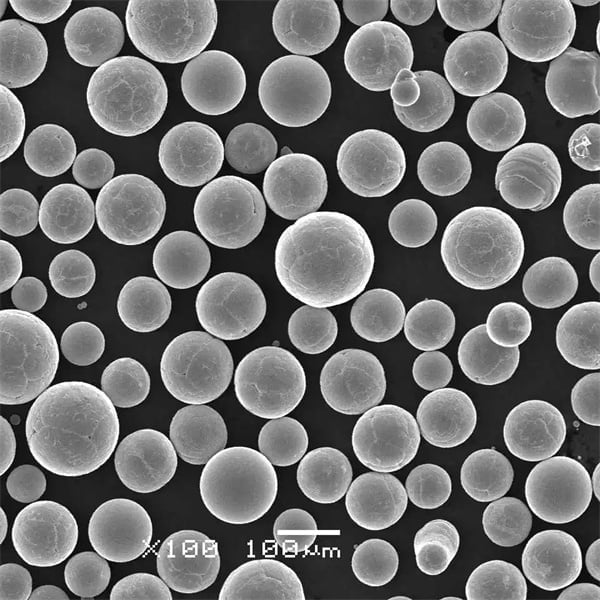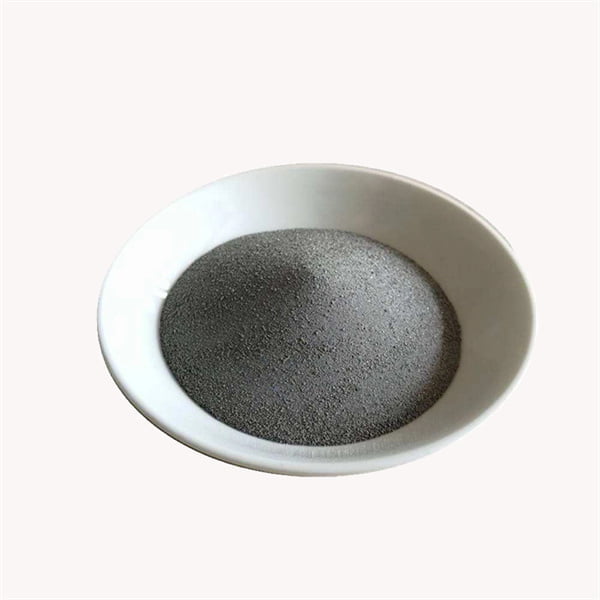FeCoCrNiMn for 3D printing
Table of Contents
The world of 3D printing is constantly evolving, with new materials pushing the boundaries of what’s possible. Enter FeCoCrNiMn, a high-entropy alloy (HEA) that’s generating excitement for its unique properties and potential to revolutionize additive manufacturing. But what exactly is FeCoCrNiMn, and how does it stack up against traditional 3D printing materials? Buckle up, because we’re diving deep into this fascinating material!
What is FeCoCrNiMn?
Imagine a material cocktail containing five elements in roughly equal proportions. That’s the essence of FeCoCrNiMn, where Fe represents iron, Co stands for cobalt, Cr signifies chromium, Ni denotes nickel, and Mn symbolizes manganese. Unlike traditional alloys dominated by a single base metal, HEAs like FeCoCrNiMn boast a more balanced composition, leading to a fascinating synergy of properties.
Here’s a table summarizing the key details of FeCoCrNiMn:
| Feature | Description |
|---|---|
| Category | High-Entropy Alloy (HEA) |
| Composition | Fe (Iron), Co (Cobalt), Cr (Chromium), Ni (Nickel), Mn (Manganese) (approximately equal proportions) |
| Structure | Face-centered cubic (FCC) or single-phase microstructure |
This unique composition grants FeCoCrNiMn some remarkable characteristics:
- High Strength: Imagine a material that can rival steel in strength. FeCoCrNiMn boasts impressive tensile strength, making it ideal for applications demanding structural integrity.
- Superior Wear Resistance: Ever wished for a material that can shrug off wear and tear with ease? FeCoCrNiMn exhibits exceptional wear resistance, a boon for parts subjected to constant friction.
- Excellent Corrosion Resistance: Rust never sleeps, but FeCoCrNiMn puts up a good fight. Its inherent corrosion resistance makes it suitable for harsh environments.
- High-Temperature Performance: When the heat is on, FeCoCrNiMn stays cool. It retains its strength and integrity at elevated temperatures, opening doors for applications in hot environments.

Applications of FeCoCrNiMn for 3D Printing
FeCoCrNiMn’s impressive properties translate into a range of potential applications in 3D printing:
| Application | Description |
|---|---|
| Aerospace Components: Imagine lightweight, high-strength aircraft parts. FeCoCrNiMn’s strength-to-weight ratio makes it a potential game-changer for aerospace components. | |
| Automotive Parts: Think of durable, wear-resistant engine components. FeCoCrNiMn’s resistance to wear and tear could revolutionize the automotive industry. | |
| Medical Implants: Biocompatible and strong, FeCoCrNiMn has the potential for creating customized, long-lasting medical implants. | |
| Tools and Dies: Imagine tools that stay sharp and resist wear for longer. FeCoCrNiMn’s properties make it suitable for creating high-performance tools and dies. | |
| Heat Exchangers: Think of efficient heat exchangers that withstand high temperatures. FeCoCrNiMn’s thermal stability makes it a potential candidate for these applications. |
These are just a few examples, and as research progresses, we can expect even more innovative uses for FeCoCrNiMn in 3D printing.
Specific Metal Powder Models for FeCoCrNiMn Printing
While FeCoCrNiMn holds immense promise, it’s still a relatively new player in the 3D printing arena. However, several companies are developing metal powder specifically designed for FeCoCrNiMn printing:
- Höganäs AM: This Swedish company offers a FeCoCrNiMn powder with a spherical morphology and high flowability, making it suitable for Laser Beam Melting (LBM) processes.
- SLM Solutions: Based in Germany, SLM Solutions offers an ATLAST FeCoCrNiMn powder specifically formulated for their selective laser melting (SLM) machines, known for their high-precision printing capabilities.
- Custom Engineered Material (CEM): This US-based company provides a range of HEA powders, including FeCoCrNiMn, with customizable particle sizes and distributions to cater to specific printing needs.
- ExOne: An industry leader in binder jetting 3D printing, ExOne is exploring the use of FeCoCrNiMn powders for this technology, potentially opening doors for high-throughput printing of complex parts.
- AMPT (Additive Manufacturing Powders Technology): This French company offers a FeCoCrNiMn powder with a focus on tight chemical composition control and excellent printability for LBM processes.
- Carpenter Additive Manufacturing: This US-based company is developing FeCoCrNiMn powders with a focus on optimizing printability and achieving exceptional mechanical properties in the final printed parts.
- LPW Technology: A leading player in powder bed fusion technologies, LPW is exploring FeCoCrNiMn powders for their selective laser melting (SLM) machines, aiming to deliver high-performance components for demanding applications.
- GE Additive: This industrial giant is actively researching HEAs, including FeCoCrNiMn, for potential use in their additive manufacturing platforms. Their expertise in materials science and large-scale manufacturing could significantly impact the adoption of FeCoCrNiMn in 3D printing.
- Elementum 3D: This company offers a range of metal powders for additive manufacturing, and FeCoCrNiMn is on their radar. Their focus on high-quality powders and advanced characterization techniques could contribute to the development of reliable FeCoCrNiMn printing processes.
It’s important to note that these are just a few of the companies pioneering FeCoCrNiMn powders for 3D printing. The market is constantly evolving, and new players are likely to emerge as research progresses.
Here’s a table summarizing the key details of these metal powder models:
| Supplier | Description | Focus | Technology Compatibility |
|---|---|---|---|
| Höganäs AM | Spherical morphology, high flowability | LBM processes | Laser Beam Melting |
| SLM Solutions | ATLAST FeCoCrNiMn powder | High-precision printing | Selective Laser Melting (SLM) |
| Custom Engineered Material (CEM) | Customizable particle sizes and distributions | Cater to specific printing needs | Various (depending on powder characteristics) |
| ExOne | Exploring for binder jetting | High-throughput printing | Binder Jetting |
| AMPT (Additive Manufacturing Powders Technology) | Tight chemical composition control, excellent printability | LBM processes | Laser Beam Melting |
| Carpenter Additive Manufacturing | Optimized printability, exceptional mechanical properties | Demanding applications | Various (depending on powder characteristics) |
| LPW Technology | Exploring for selective laser melting (SLM) | High-performance components | Selective Laser Melting (SLM) |
| GE Additive | Research and development stage | Potential for various AM platforms | To be determined |
| Elementum 3D | Focus on high-quality powders | Reliable FeCoCrNiMn printing processes | Various (depending on powder characteristics) |
Choosing the right FeCoCrNiMn powder depends on several factors, including the specific 3D printing technology being used, the desired part properties, and the application. As with any new material, thorough testing and qualification of the powder are crucial for achieving successful printing results.
Advantages and Disadvantages of FeCoCrNiMn for 3D Printing
FeCoCrNiMn presents exciting possibilities, but like any material, it has its own set of pros and cons:
Advantages:
- Superior Mechanical Properties: FeCoCrNiMn boasts impressive strength, wear resistance, and high-temperature performance, making it suitable for demanding applications.
- Lightweight Alternative: Compared to traditional metals, FeCoCrNiMn offers a good strength-to-weight ratio, potentially leading to lighter and more efficient components.
- Corrosion Resistance: FeCoCrNiMn’s inherent corrosion resistance makes it a viable option for parts exposed to harsh environments.
- Design Freedom: 3D printing allows for complex geometries, and FeCoCrNiMn’s potential for high-performance parts expands design possibilities.
Disadvantages:
- Limited Availability: FeCoCrNiMn powders are still under development, and their availability might be limited compared to established materials.
- Higher Cost: As a relatively new material, FeCoCrNiMn powders can be more expensive than traditional options.
- Process Challenges: 3D printing FeCoCrNiMn might require specialized printing parameters and expertise to achieve optimal results.
- Limited Research: While research is ongoing, the long-term performance and behavior of FeCoCrNiMn in printed parts need further investigation.
Weighing the advantages and disadvantages is crucial before diving into FeCoCrNiMn printing. The potential benefits are significant, but careful consideration of the challenges and limitations is essential for making informed decisions.

FAQ
| Question | Answer |
|---|---|
| What are the benefits of using FeCoCrNiMn for 3D printing? | FeCoCrNiMn offers a compelling combination of superior mechanical properties, including high strength, wear resistance, and high-temperature performance. It can also be a lightweight alternative to traditional metals and exhibits inherent corrosion resistance. These properties make it suitable for demanding applications in aerospace, automotive, and other industries. Additionally, 3D printing allows for the creation of complex geometries with FeCoCrNiMn, expanding design possibilities. |
| What are the challenges of using FeCoCrNiMn for 3D printing? | Despite its potential, FeCoCrNiMn presents some challenges. The availability of FeCoCrNiMn powders is still limited compared to established materials, and the cost can be higher. Printing FeCoCrNiMn might require specialized printing parameters and expertise to achieve optimal results due to its unique properties. Additionally, research on the long-term performance and behavior of FeCoCrNiMn in printed parts is still ongoing. |
| Is FeCoCrNiMn right for my 3D printing project? | The suitability of FeCoCrNiMn for your project depends on your specific needs and priorities. If your project demands high strength, wear resistance, or high-temperature performance, and you’re willing to navigate the challenges of a new material, FeCoCrNiMn could be a good option. However, if cost or immediate availability are major concerns, established materials might be a better choice for now. Carefully consider your project requirements, weigh the pros and cons of FeCoCrNiMn, and consult with 3D printing experts to make an informed decision. |
| What are some future prospects for FeCoCrNiMn in 3D printing? | The future of FeCoCrNiMn in 3D printing is promising. As research progresses, powder availability and cost are expected to improve. Advancements in printing techniques tailored for FeCoCrNiMn will likely lead to more consistent and predictable printing results. Furthermore, ongoing research on the material’s properties could unlock even more potential applications. With continued development, FeCoCrNiMn has the potential to become a game-changer in the 3D printing landscape. |
In conclusion, FeCoCrNiMn represents a fascinating new material with the potential to revolutionize 3D printing for demanding applications. While challenges exist, ongoing research and development are paving the way for wider adoption. As the technology matures, FeCoCrNiMn could play a significant role in shaping the future of additive manufacturing.
Share On
MET3DP Technology Co., LTD is a leading provider of additive manufacturing solutions headquartered in Qingdao, China. Our company specializes in 3D printing equipment and high-performance metal powders for industrial applications.
Inquiry to get best price and customized Solution for your business!
Related Articles
About Met3DP
Recent Update
Our Product
CONTACT US
Any questions? Send us message now! We’ll serve your request with a whole team after receiving your message.

Metal Powders for 3D Printing and Additive Manufacturing
COMPANY
PRODUCT
cONTACT INFO
- Qingdao City, Shandong, China
- [email protected]
- [email protected]
- +86 19116340731

















